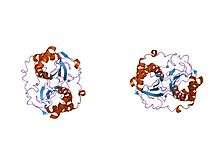S-ribosylhomocysteine lyase
| S-ribosylhomocysteine lyase | |||||||||
|---|---|---|---|---|---|---|---|---|---|
| Identifiers | |||||||||
| EC number | 4.4.1.21 | ||||||||
| CAS number | 37288-63-4 | ||||||||
| Databases | |||||||||
| IntEnz | IntEnz view | ||||||||
| BRENDA | BRENDA entry | ||||||||
| ExPASy | NiceZyme view | ||||||||
| KEGG | KEGG entry | ||||||||
| MetaCyc | metabolic pathway | ||||||||
| PRIAM | profile | ||||||||
| PDB structures | RCSB PDB PDBe PDBsum | ||||||||
| Gene Ontology | AmiGO / EGO | ||||||||
| |||||||||
| S-Ribosylhomocysteinase (LuxS) | |||||||||
|---|---|---|---|---|---|---|---|---|---|
 crystal structure of autoinducer-2 production protein (luxs) from Haemophilus influenzae | |||||||||
| Identifiers | |||||||||
| Symbol | LuxS | ||||||||
| Pfam | PF02664 | ||||||||
| Pfam clan | CL0094 | ||||||||
| InterPro | IPR003815 | ||||||||
| SCOP | 1inn | ||||||||
| SUPERFAMILY | 1inn | ||||||||
| |||||||||
In enzymology, a S-ribosylhomocysteine lyase (EC 4.4.1.21) is an enzyme that catalyzes the chemical reaction
- S-(5-deoxy-D-ribos-5-yl)-L-homocysteine L-homocysteine + (4S)-4,5-dihydroxypentan-2,3-dione
Hence, this enzyme has one substrate, S-(5-deoxy-D-ribos-5-yl)-L-homocysteine, and two products, L-homocysteine and (4S)-4,5-dihydroxypentan-2,3-dione.
This enzyme belongs to the family of lyases, specifically the class of carbon-sulfur lyases. The systematic name of this enzyme class is S-(5-deoxy-D-ribos-5-yl)-L-homocysteine L-homocysteine-lyase [(4S)-4,5-dihydroxypentan-2,3-dione-forming]. Other names in common use include S-ribosylhomocysteinase, and LuxS. This enzyme participates in methionine metabolism.
Furthermore, LuxS is involved in the synthesis of autoinducer AI-2 (autoinducer-2), which is plays a role in quorum sensing in a certain number of bacterial species. LuxS converts S-ribosylhomocysteine to homocysteine and 4,5-dihydroxy-2,3-pentanedione (DPD); DPD can then spontaneously cyclisize to active AI-2.[1][2] AI-2 is a signalling molecule that is believed to act in interspecies communication by regulating niche-specific genes with diverse functions in various bacteria, often in response to population density. However, an unequivocally AI-2 related behavior was found to be restricted primarily to bacteria bearing known AI-2 receptor genes.[3] Thus, while it is certainly true that some bacteria can respond to AI-2, it is doubtful that it is always being produced for purposes of signalling. LuxS is a homodimeric iron-dependent metalloenzyme containing two identical tetrahedral metal-binding sites similar to those found in peptidases and amidases.[4]
Structural studies
As of late 2007, 3 structures have been solved for this class of enzymes, with PDB accession codes 1JQW, 2FQO, and 2FQT.
References
- ↑ van Houdt R, Moons P, Jansen A, Vanoirbeek K, Michiels CW (September 2006). "Isolation and functional analysis of luxS in Serratia plymuthica RVH1". FEMS Microbiol. Lett. 262 (2): 201–9. doi:10.1111/j.1574-6968.2006.00391.x. PMID 16923076.
- ↑ Zhu J, Patel R, Pei D (August 2004). "Catalytic mechanism of S-ribosylhomocysteinase (LuxS): stereochemical course and kinetic isotope effect of proton transfer reactions". Biochemistry. 43 (31): 10166–72. doi:10.1021/bi0491088. PMID 15287744.
- ↑ Rezzonico, F.; Duffy, B. (2008). "Lack of genomic evidence of AI-2 receptors suggests a non-quorum sensing role for LuxS in most bacteria". BMC Microbiology. 8: 154. doi:10.1186/1471-2180-8-154. PMID 18803868.
- ↑ Rajan R, Zhu J, Hu X, Pei D, Bell CE (March 2005). "Crystal structure of S-ribosylhomocysteinase (LuxS) in complex with a catalytic 2-ketone intermediate". Biochemistry. 44 (10): 3745–53. doi:10.1021/bi0477384. PMID 15751951.
Further reading
- Zhu J, Dizin E, Hu X, Wavreille AS, Park J, Pei D (2003). "S-Ribosylhomocysteinase (LuxS) is a mononuclear iron protein". Biochemistry. 42 (16): 4717–26. doi:10.1021/bi034289j. PMID 12705835.
- Miller MB, Bassler BL (2001). "Quorum sensing in bacteria". Annu. Rev. Microbiol. 55: 165–99. doi:10.1146/annurev.micro.55.1.165. PMID 11544353.
This article incorporates text from the public domain Pfam and InterPro IPR003815